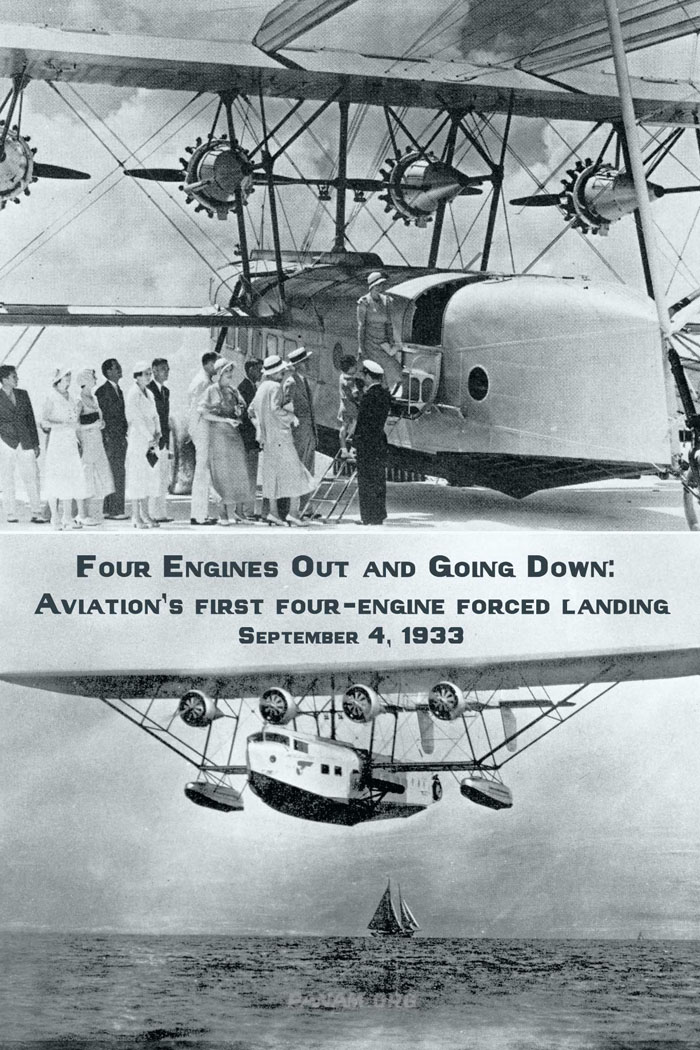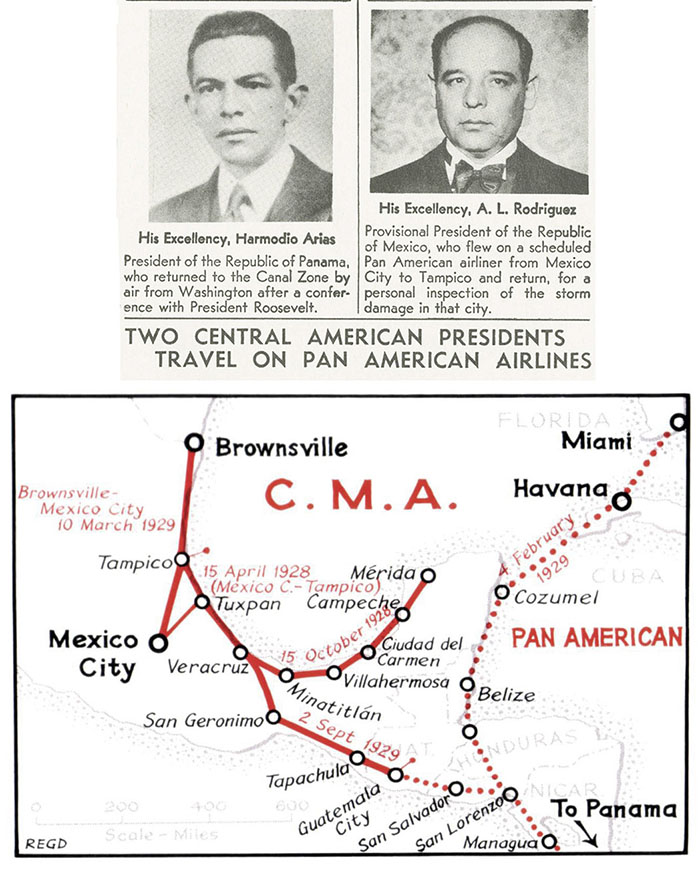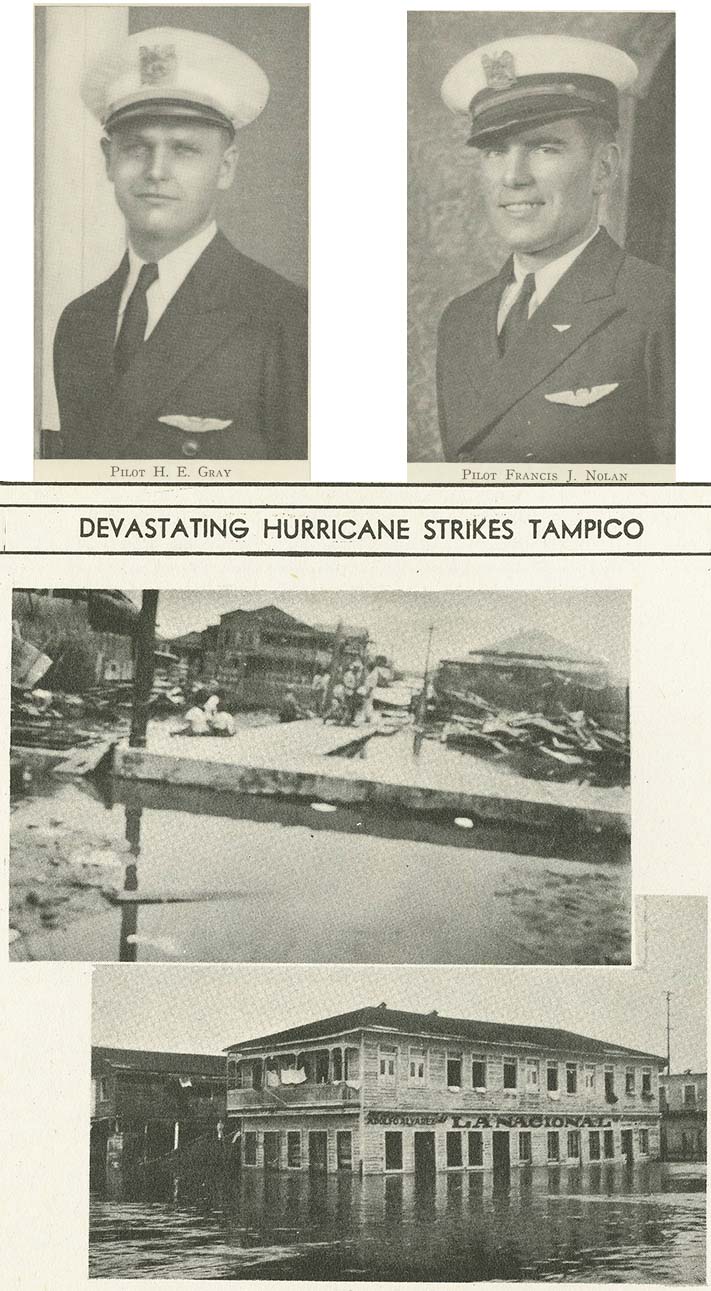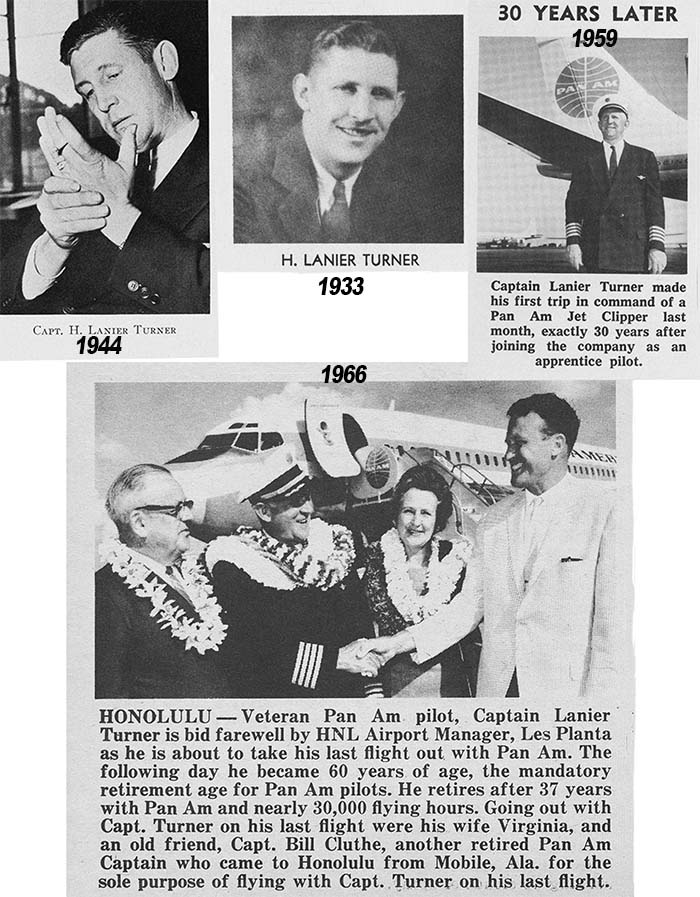SEPTEMBER 1933
Scroll down to read
Four September 1933 posts

Sept 4, 1933
“A World Record (Unwanted)”
 Photomontage: Pan Am passengers board a Sikorsky S-40 and Pan Am S-40 aloft (PAHF collection).
Photomontage: Pan Am passengers board a Sikorsky S-40 and Pan Am S-40 aloft (PAHF collection).
Pan American Airways’ Sunday, September 3, 1933, Miami to Panama service was a mess. A Category 4 Hurricane hammering the Bahamas delayed the Caribbean Clipper’s (Sikorsky S-40, NC81V) four-day Barranquilla, Colombia round-trip departure. Storm-related winds and politically fueled tempers in Cuba slowed the Sikorsky S-40’s progress all day. As Captain Stanley “Red” Williamson left Havana’s waterfront hours late for Cienfuegos, 145 miles southeast, he shared contingency plans with copilot Paul Young.
The flight window was closing, and policy forbade nighttime water landings. His post-Cienfuegos stop, Kingston, Jamaica, was a four-and-a-half hour flight and the September sunset-to-dark window was 25 minutes, so Red would not attempt the open-water crossing. Pan Am’s Manzanillo emergency seaplane base lay 250 miles east of Cienfuegos and 160 miles from Kingston. By overnighting at Manzanillo, then leaving at first light on the 160 mile/1.5 hour open-water run to Kingston and executing a fast passenger/mail/fuel exchange, the flight could meet its Monday-afternoon Barranquilla, Colombia rendezvous with Wallace “Wally” Culbertson flying Consolidated Commodore NC670M from Cristobal, Panama.
Things turned dicey in Manzanillo, however, as Red learned that the town’s police chief and mayor had been shot and his passengers’ bags stolen. Ongoing street tumult limited crew and passengers to little sleep. Still, Red left orders for a before-dawn refueling and exit.
One hour after takeoff, 6:45 a.m. Monday, September 4, 1933, with exhausted passengers and crew, Red encountered a crisis: atop the 6,000-foot climb needed to cross Jamaica’s east-to-west mountain ridge all four Pratt & Whitney 9-cylinder radial engines died. He pulled the yoke for a hard left trying for Jamaica’s north coast, about 10 miles northeast, while his radio operator sent a “going down” message. Professional panic ensued as “ears” throughout the company’s radio network listened.
Within the hour Pan Am learned that Captain Williamson landed the Caribbean Clipper at Port Annotto, according to co-pilot Young, bouncing the S-40’s tail on the beach doing so.
Pan Am officials in Miami and New York City later ascertained that Captain Williamson entered commercial aviation’s history books with the world’s commercial first four-engine emergency landing. Other successful emergency landings would define Pan Am’s industry-setting commitment to by-the-book flying and crew training.
Sources:
• Banning, Gene. Airlines of Pan American since 1927. Paladwr Press, 2001. pp. 68-9.
• Hobson, Eric H. “PAA Through Kingston, 1940-1934,” author’s collection.
For more on this story, see Hobson, Eric H. “Four Engines Out and Going Down: Aviation’s first four-engine forced landing, September 4, 1933” at https://www.panam.org/take-off/831-s-40-4-engines-out
Sept 13, 1933
“Presidents Take Wing”
 Composite: “Pan American Airways,” October-November 1933, Vol 4, No. 5, cover. https://digitalcollections.library.miami.edu/digital/collection/asm0341/id/41170/rec/30
Composite: “Pan American Airways,” October-November 1933, Vol 4, No. 5, cover. https://digitalcollections.library.miami.edu/digital/collection/asm0341/id/41170/rec/30
Route Map: Compañía Mexicana de Aviación CMA & PAA Western Division Route Map (Courtesy of R.E.G. Davies)
By 1933 Pan American Airways staff handled celebrities and economic power brokers with ease:
Comedian Will Rogers,
Actor Douglas Fairbanks,
Miss Jamaica, Ouida Calnek,
Playboy William Randolph Hearst, Jr., and
Playwright Noel Coward.
Ground personnel knew when to notify or not to notify photographers and to accept aliases when tact required.
In mid-September 1933, Western Division personnel were entrusted with the lives of two heads of state: A.L. Rodriguez, President of Mexico and Harmodio Arias, President of the Republic of Panama. They both boarded Pan Am’s regularly scheduled Pan Am Ford Tri-Motor aircraft on official business.
President Arias, returning from a Washington, D.C. meeting with President Franklin Roosevelt, boarded at Brownsville, TX to fly Pan Am’s Brownsville-to-Panama route, stopping in Mexico City where his First Lady met him.
President Rodriguez boarded at Mexico City, flying the Mexico City-Tampico run to gather first-hand information about damage inflicted by two hurricanes that battered Tampico within two weeks. He sent thanks to Pan Am, stating “the 30 minute flight over the city … gave him such a comprehensive view of the damage he felt nothing would be gained by a survey on the ground.”
Pan Am had carried other heads of state before this:
President Louis Borno, Republic of Haiti,
President C. Gonzales Viquez, Republic of Costa Rica, and
President Gerardo Machado, Cuba.
Many U.S. diplomats also flew on Pan Am:
Governor Theodore Roosevelt, Jr. of Puerto Rico;
Members of the British Royal family, including:
The Prince of Wales and Prince George,
The Duchess of Northumberland and her daughters, and
The Duke of Sutherland.
However a full decade passed before Pan Am carried a sitting U.S. President. It was on January 11, 1943 that President Franklin D. Roosevelt boarded Pan Am’s “Dixie Clipper” (Boeing B-314, NC18605) from Miami, stopping overnight in Trinidad. The following day, the Boeing 314 departed, with a brief stop in Belem Brazil, before flying across the Atlantic to Africa. There FDR met British Prime Minister Winston Churchill for the historic “Casablanca Conference.”
Sources:
“Pan American Air Ways”: Vols.4, No.5, p. 1; Vol.4, No.2, p. 2; Vol.3, No.3, p. 17; Vol.1, No.6, p.3; Vol1, No.7, p.1; and Vol.2, No.1, p.1.
Sept 21, 1933
“A Three-foot Shift to the Left”
Article Sources & Photomontage:
“Clipper,” Vol.15, No. 9 (December 1959), pp. 1&2. https://digitalcollections.library.miami.edu/digital/collection/asm0341/id/64714/rec/9
“New Horizons,” Vol.12, No. 4 (January 1942), p.25.
https://digitalcollections.library.miami.edu/digital/collection/asm0341/id/48565/rec/12
“Pan American Air Ways,” Vol. 4, No. 5 (October 1933), p. 24.
https://digitalcollections.library.miami.edu/digital/collection/asm0341/id/41166/rec/5
“Pan American Clipper,” Vol. 25, No. 17 (August 15, 1966), p. 4 https://digitalcollections.library.miami.edu/digital/collection/asm0341/id/74095/rec/18
After four years bouncing around Pan American Airways’ Caribbean and Western routes as an apprentice/co-pilot, with a sprinkling of temporary pilot stints, Harry Lanier Turner advanced to Pilot in late summer 1933. To shift left in the cockpit, however, he was leaving his wife, Virginia, and daughters, four-year-old Jacquelyn and two-year-old Virginia Jane, in Miami. As he joined the Brazilian Division to fly Consolidated Commodores, Sikorsky S-42s and S-43s in and out of Para, Brazil, Turner also left his first name behind to fly as Captain, H. Lanier Turner.
Turner’s family joined him in Brazil a year later where they remained until November 1936 when they returned to Miami. As Pan Am’s transpacific service matured and “Masters of Flying Boats,” Captains Harold Gray, R.O.D. Sullivan, Charles Lorber, and Mike LaPorte left Alameda, California for Baltimore, Maryland to establish transatlantic service, Turner was sent west to backfill crew slots. He would remain on the west coast for the remainder of his thirty-seven-year Pan Am career.
Lanier Turner flew many important flights for the Pacific Division, notably commanding the Boeing 314 “Anzac Clipper” (NC 18611) on its December 7, 1941 Alameda-to-Honolulu flight, during which he followed Pan Am’s secret order, PLAN A, and diverted to Hilo to avoid Japanese detection. In a Boeing 707 eighteen years later, Turner set an 8-hour-11-minute record on the Tokyo-to-Seattle “Great Northern Circle” run.
Captain Turner’s final flight occurred July 23, 1966, one day before his 60th birthday and mandatory retirement. Accompanying him from Hawaii home to San Francisco were his wife, Virginia, and close friend, Pan Am first-generation pilot, William “Bill” Cluthe.
H. Lanier Turner’s 30,000 flight hours over 37 years illustrated Pan Am’s aviation footprint: he flew Depression-Era Ford Tri-Motor 5-AT “Tin Gooses,” Post-War Boeing 377 “Stratocruisers,” and finally Jet-Age Boeing 707s.
Sept 29, 1933
“One-Eyed Monster of Destruction ”

Photo compilation: Top left: Harold Gray (1930): https://digitalcollections.library.miami.edu/digital/collection/asm0341/id/40812/rec/9 Pan American Air Ways, Vol. 1, No. 12, November 15, 1930, Page 4 / Top right: Francis J. Nolan (1930): https://digitalcollections.library.miami.edu/digital/collection/asm0341/id/40813/rec/9 Pan American Air Ways, Vol. 1, No. 12, November 15, 1930. p.5 / Bottom:“Hurricane hits Tampico, MX,” Pan American Air Ways, Vol. 4.No. 5, p.2. https://digitalcollections.library.miami.edu/digital/collection/asm0341/id/41144/rec/5
Using information provided by "Pan American Airways," the Monday September 25, 1933 evening edition of the Brownsville, Texas, “Brownsville Herald” announced the destruction of Tampico, Mexico by a “one-eyed monster of destruction from the tropics.”
As the hurricane came ashore Saturday night, the 23rd, blowing at 120mph, pilot Harold Gray saw and heard the “one-eyed monster” first hand. As he had done eight days earlier (Friday, September 15) when another Category 2 hurricane hammered Tampico, he sheltered at Tampico’s Rihl Field terminal while his Ford Trimotor 5-AT sat in the field’s storm-hardened hanger.
By Sunday morning the storm had lost its punch and, after finding airport damage limited to roof loss, Harold drove into Tampico. At noon he reported to D.G. Richardson, Pan Am’s Brownsville operations manager: “Untold damage and misery in Tampico. Martial law has been declared. Authorities consider the storm the worst catastrophe in the history of the city.” His colleague, Pilot Francis J. Nolan, confirmed Gray’s grim assessment that afternoon as he flew over Tampico on Compañía Mexicana de Aviación’s daily Brownsville to Mexico City flight (bypassing the route’s normal Tampico stop).
For several days Rihl Field staff used the area’s only working radio (mounted in a Ford 5-AT) to send news and needs assessments. Tampico’s situation was dire: infrastructure that survived the September 14-15 storm was destroyed and more than 5,000 residents were injured or killed. Rihl Field began to receive aircraft Tuesday bearing medical teams and relief supplies, but days passed before train service could be restored and relief efforts could accelerate to the scale needed.
Brownsville Herald readers understood Tampico’s situation. They had endured a recent hurricane hit -- a Category 5 storm that scoured Cuba on September 1 as, came ashore at Brownsville four days later (Tuesday, September 5) with a 125 m.p.h. punch.
Sources:
“Wind Leaves Many Dead at Tampico” The Brownsville Herald, Vol. 25, Sept. 1933, p. 1
“Hurricane hits Tampico, MX,” Pan American Air Ways, Vol. 4.No. 5, p.2. https://digitalcollections.library.miami.edu/digital/collection/asm0341/id/41144/rec/5
“1933 Atlantic Hurricane Season.” Wikipedia. 2023.
Go back to "90 Years Ago" main page

